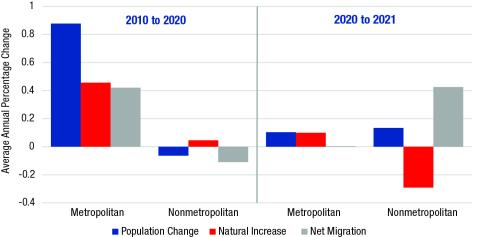Key Findings

Recent research1 suggests that the turbulent economic, social, and epidemiological conditions of recent years altered traditional demographic trends in non-metropolitan America. Between 2010 and 2020, nonmetropolitan (rural) America lost population for the first time in history because more people left rural areas than moved to them and because the excess of births over deaths dwindled. Yet, the latest Census Bureau population estimates document renewed population gains in nonmetropolitan America between April 2020 and July 2021. In fact, the rural population gain exceeded that in metropolitan areas, something that is rare in American history (Figure 1). This recent nonmetropolitan population increase occurred because a substantial net migration gain offset the growing excess of deaths over births fostered by COVID-19. In contrast, recent metropolitan population gains were smaller because of less natural increase and smaller net migration gains than between 2010 and 2020. Most of the recent nonmetropolitan population increase accrued to high amenity recreational and retirement areas because net migration gains to these counties accelerated early in the pandemic. Elsewhere in rural America, many areas continued to lose population, but a sizable number of counties had population increases because modest migration gains offset deaths from COVID-19. In many counties with histories of population loss, only sustained net migration gains can provide the demographic lifeline these communities need to stave off depopulation. Whether these nonmetropolitan migration gains will continue in this turbulent era remains to be seen.

Source: Census Bureau Population Estimates Program 2021 and Decennial Census 2020 and 2010
1. This research summarizes my recent analysis in Rural Sociology.
Kenneth M. Johnson is senior demographer at the Carsey School of Public Policy, professor of sociology at the University of New Hampshire, and an Andrew Carnegie Fellow. His research was supported by a UNH Faculty Scholar Award and by the New Hampshire Agricultural Experiment Station in support of Hatch Multi-State Regional Project W-4001 through joint funding of the National Institute of Food and Agriculture, U.S. Department of Agriculture, under award number 1013434, and the state of New Hampshire. The opinions are his and not those of the sponsoring organizations. The research assistance of Kristine Bundschuh and Tyrus Parker, as well as the GIS work of Barb Cook, are gratefully acknowledged.